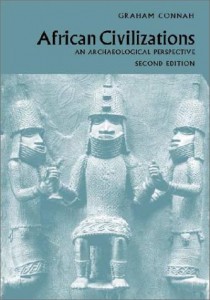
African Civilizations by Graham Connah
I love Ethiopia, and not just because Ethiopian restaurants are my favorite restaurants. In ancient times, they had a nation-state with gold, silver and bronze coinage, grand architecture at the same time that the Greeks were building the Parthenon, a queen of Sheba who was rockin’ out with Solomon. Also, Ethiopia lasted continuously and independently until the late 20th century, and they were the longest-lasting Christian nation in the world (converting in the 4th century). Not until the 70s and 80s did they suffer the violence and famines that gave them the reputation as the poster child for third-world misery.
The existence of a powerful Christian nation in Africa may have influenced the medieval Europe myth of Prester John, the magical African king who ruled a land filled with gold and gems where there was no poverty. Apparently envoys to Prester John occasionally delivered their messages to a king of Ethiopia, to his confusion.
Ethiopia has an interesting geography: it’s largely highlands, and the elevation means that there are a lot of climates very close to each other, from Alpine to temperate to swamp to desert to seashore (if you count Eritrea as part of Ethiopia, which it was until the 90s). A campaign set in an Ethiopia-like area would put the PCs in a few day’s travel of almost every terrain type that has its own map icon in the D&D Expert set.
Ethiopian Adventures
Here are some ideas I have for adventures in an Ethiopia-like environment.
Like the north of Scotland, the Ethiopian highlands have fertile, hospitable valleys between rocky highlands. Besides mountains, the Ethiopian highlands have plateaus that were too windy to be heavily populated in ancient and medieval times. Imagine this, but oversaturated in typical fantasy fashion: a vast, windswept, flat plateau. Storm winds whistle over it constantly, strong enough to constitute a serious danger for adventurers. Witches and spirits ride the winds. The plateau is, however, crisscrossed with fertile valleys and gorges, many cut off from their neighbors. In such a geography, building a road would be a matter of digging a ditch (or tunnel) between valleys, and paving the bottom.
One of the problems of Ethiopian agriculture is a cyclical infestation of giant locusts that can cause famine. Obviously in D&D the locusts would be a dangerous swarm, but besides their utility as monsters, they could be a good plot driver. Imagine that our D&D highlands have some mountain barbarian tribes, modeled perhaps after Scottish highlanders. Every 7 years, locusts eat all their crops: therefore, every 7 years is a “raid year” where all the warriors descend on the surrounding areas to loot and pillage their food. This is now a sacred custom, and no highlander is considered a warrior until their “raid year”. Because the locust infestation occurs every 7 years, it is predictable to its victims; therefore, a D&D adventure could be built around PCs preparing defenses against the Raid Year, which happens to be coming up in a couple of months.
The Great Rift Valley, which runs through the Ethiopian highlands, is also an amazing adventure location.
Tags: everybook
This entry was posted on Friday, August 20th, 2010 at 3:50 pm and is filed under fluff/inspiration, news, RPG Hub. You can follow any responses to this entry through the RSS 2.0 feed.
You can leave a response, or trackback from your own site.








[…] However, the interaction of these two milieus provided some interesting and peculiar details. The Plateau of Spirits and the Raid Year, the sacrifice of the Stag King, the roadside altars, the Wind of No Return, the Elves of the […]